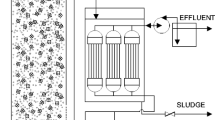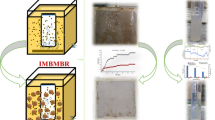Abstract
Wastewater treatment using moving bed membrane bioreactor technology was tested with real urban wastewater at a pilot plant, combining moving bed treatment as a biological process with hybrid biomass (suspended and fixed) and the advantages of a membrane separation system. The evolution of the kinetic constants of the hybrid biomass and organic matter removal were studied in a pilot plant under different operational conditions, by varying hydraulic retention time (HRT), mixed liquor suspended solids (MLSS) and temperature, and considering the attached biomass of the carrier and the dispersed biomass of the flocs to reproduce real treatment conditions. The rates of organic matter removal were 97.73 ± 0.81 % of biochemical oxygen demand (BOD5), 93.44 ± 2.13 % of chemical oxygen demand (COD), 94.41 ± 2.26 % of BOD5 and 87.62 ± 2.47 % of COD using 24.00 ± 0.39 and 10.00 ± 0.07 h of HRT, respectively. The influence of the environmental variables and operational conditions on kinetic constants was studied; it was determined that the most influential variable for the decay coefficient for heterotrophic biomass was HRT (0.34 ± 0.14 and 0.31 ± 0.10 days−1 with 10.00 ± 0.07 and 24.00 ± 0.39 h of HRT, respectively), while for heterotrophic biomass yield, this was temperature (0.61 ± 0.04 and 0.52 ± 0.06 with 10.00 ± 0.07 and 24.00 ± 0.39 h of HRT, respectively). The results show that introducing carriers in an MBR system provides similar results for organic matter removal, but with a lower concentration of MLSS.




Similar content being viewed by others
References
Ahl RM, Leiknes T, Ødegaard H (2006) Tracking particle size distributions in a moving bed biofilm membrane reactor for treatment of municipal wastewater. Water Sci Technol 53:33–42
APHA (1992) Standard Methods for the Examination of Water and Wastewater, 18th edn. American Public Health Association, Washington DC
Canziani R, Emondi V, Garavaglia M, Malpei F, Pasinetti E, Buttiglieri G (2006) Effect of oxygen concentration on biological nitrification and microbial kinetics in a cross-flow membrane bioreactor (MBR) and moving-bed biofilm reactor (MBBR) treating old landfill leachate. J Membr Sci 286:202–212
Davis JA, Harrison K, Shields B (2009) Compact technology: increasing treatment capacity without building more basins. Fla Water Resour 7:24–29
De Sanctis M, Di Iaconi C, Lopez A, Rossetti S (2010) Granular biomass structure and population dynamics in a sequencing batch biofilter granular reactor (SBBGR). Bioresour Technol 101:2152–2158
Falletti L, Conte L (2007) Upgrading of activated sludge wastewater treatment plants with hybrid moving-bed biofilm reactors. Ind Eng Chem Res 46:6656–6660
Ferrai M, Guglielmi G, Andreottola G (2010) Modelling respirometric tests for the assessment of kinetic and stoichiometric parameters on MBBR biofilm for municipal wastewater treatment. Environ Modell Softw 25:626–632
Germain E, Stephenson T, Pearce P (2005) Biomass characteristics and membrane aeration: toward a better understanding of membrane fouling in submerged membrane bioreactors (MBRs). Biotechnol Bioeng 90(3):316–322
Germain E, Bancroft L, Dawson A, Hinrichs C, Fricker L, Pearce P (2007) Evaluation of hybrid processes for nitrification by comparing MBBR/AS and IFAS configurations. Water Sci Technol 55(8–9):43–49
Gomez M, Dvorak L, Ruzickova I, Holba M, Wanner J (2012) Operational experience with a seasonally operated full-scale membrane bioreactor plant. Bioresour Technol 121:241–247
Gómez-Silván C, Molina-Muñoz M, Poyatos JM, Ramos A, Hontoria E, Rodelas B, González-López J (2010) Structure of archaeal communities in membrane-bioreactor and submerged-biofilter wastewater treatment plants. Bioresour Technol 101:2096–2105
Helle S (1999) A respirometric investigation of the activated sludge treatment of BKME during steady state and transient operating conditions. Ph.D. thesis, University of British Columbia
Henze M, Gujer W, Mino T, Van Loosdrecht MCM (2000) Activated sludge models ASM1, ASM2, ASM2d and ASM3. IWA Publishing, London
Ivanovic I, Leiknes T (2008) Impact of aeration rates on particle colloidal fraction in the biofilm membrane bioreactor (BF-MBR). Desalination 231:182–190
Ivanovic I, Leiknes T, Ødegaard H (2008) Fouling control by reduction of submicron particles in a BF-MBR with an integrated flocculation zone in the membrane reactor. Separ Sci Technol 43:1871–1883
Judd S (2010) The MBR book. Principles and applications of membrane bioreactors for water and wastewater treatment. Oxford, Butterworth Heinemann
Kermani M, Bina B, Movahedian H, Amin MM, Nikaein M (2008) Application of moving bed biofilm process for biological organics and nutrients removal from municipal wastewater. Am J Environ Sci 4:675–682
Kim H, Gellner J, Boltz J, Freudenberg R, Gunsch C (2010) Effects of integrated fixed film activated sludge media on activated sludge settling in biological nutrient removal systems. Water Res 4(4):1553–1561
Krzeminski P, Iglesias-Obelleiro A, Madebo G, Garrido JM, VanderGraaf JHJM, VanLier JB (2012) Impact of temperature on raw wastewater composition and activated sludge filterability in full-scale MBR systems for municipal sewage treatment. J Membr Sci 423–424:348–361
Leiknes L, Ødegaard H (2007) The development of a biofilm membrane bioreactor. Desalination 202:135–143
Lepš J, Šmilauer P (1999) Multivariate Analysis of Ecological Data. University of South Bohemia, Ceské Budejovice, Faculty of Biological Sciences
Mannina G, Viviani G (2009) Hybrid moving bed biofilm reactors: an effective solution for upgrading a large wastewater treatment plant. Water Sci Technol 60:1103–1116
Martín-Pascual J, López-López C, Cerdá A, González-López J, Hontoria E, Poyatos JM (2012) Comparative kinetic study of carrier type in a moving bed system applied to organic matter removal in urban wastewater treatment. Water Air Soil Poll 223:1699–1712
Melin E, Leiknes T, Helness H, Rasmussen V, Ødergard H (2005) Effect of organic loading rate on a wastewater treatment process combining moving bed biofilm and membrane reactors. Water Sci Technol 51:421–430
Najafpour G, Yieng HA, Younesi H, Zinatizadeh A (2005) Effect of organic loading on performance of rotating biological contactors using palm oil mill effluents. Process Biochem 40:2879–2884
Ødegaard H, Rusten B, Westrum T (1994) A new moving bed biofilm reactor-applications and results. Water Sci Technol 29:157–165
Plattes M, Henry E, Schosseler PM, Weidenhaupt A (2006) Modelling and dynamic simulation of a moving bed bioreactor for the treatment of municipal wastewater. Biochem Eng J 32:61–68
Plattes M, Henry E, Schosseler PM (2008) A zero-dimensional biofilm model for dynamic simulation of moving bed bioreactor systems: model concepts, peterson matrix, and application to a pilot-scale plant. Biochem Eng J 40:392–398
Poyatos JM, Molina-Muñoz M, Delgado F, González-López J, Hontoria E (2008) Flux influence on membrane fouling in a membrane bioreactor system under real conditions with urban wastewater. J Environ Sci Health A Tox Hazard Subst Environ Eng 43:1685–1691
Rahimi Y, Torabian A, Mehrdadi N, Habibi-Rezaie M, Pezeshk H, Nabi-Bidhendi G (2011) Optimizing aeration rates for minimizing membrane fouling and its effect on sludge characteristics in a moving bed membrane bioreactor. J Hazard Mater 186:1097–1102
Rodríguez FA, Poyatos JM, Reboleiro-Rivas P, Osorio F, González-López J, Hontoria E (2011) Kinetic study and oxygen transfer efficiency evaluation using respirometric methods in a submerged membrane bioreactor using pure oxygen to supply the aerobic conditions. Bioresour Technol 102:6013–6018
Rodríguez FA, Reboleiro-Rivas P, Osorio F, Martínez-Toledo MV, Hontoria E, Poyatos JM (2012) Influence of mixed liquid suspended solids and hydraulic retention time on oxygen transfer efficiency and viscosity in a submerged membrane bioreactor using pure oxygen to supply aerobic conditions. Biochem Eng J 60:135–141
Ruiz LM, Arévalo J, Parada J, González D, Moreno B, Pérez J, Gómez MA (2011) Respirometric assays of two different MBR (microfiltration and ultrafiltration) to obtain kinetic and stoichiometric parameters. Water Sci Technol 63:2478–2485
Rusten B, Eikebrokk B, Ulgenes Y, Lygren E (2006) Design and operations of the kaldnes moving bed biofilm reactors. Aquacult Eng 34:322–331
Rutt K, Seda J, Johnson CH (2006) Two year case study of integrated fixed film activated sludge (IFAS) at Broomfield, CO WWTP. Proceedings of the water environment federation 225–239
Sokół W, Ambaw A, Woldeyes B (2009) Biological wastewater treatment in the inverse fluidised bed reactor. Chem Eng J 150:63–68
Sriwiriyarat T, Randall CW (2005) Performance of IFAS wastewater treatment processes for biological phosphorus removal. Water Res 39(16):3873–3884
Trapani DD, Mannina G, Torregrossa M, Viviani G (2010) Quantification of kinetic parameters for heterotrophic bacteria via respirometry in a hybrid reactor. Water Sci Technol 61:1757–1766
Trapani DD, Capodici P, Cosenza A, Di Bella G, Mannina G, Torregrossa M, Viviani G (2011) Evaluation of biomass activity and wastewater characterization in a UCT-MBR pilot plant by means of respirometric techniques. Desalination 269:190–197
Van der Roest HF, Lawrence DP, Van Bentem AGN (2002) Membrane Bioreactors for Municipal Wastewater Treatment. IWAI Publishing, Cornwall
Wang XM, Wang JL (2012) Denitrification of nitrate-contaminated groundwater using biodegradable snack ware as carbon source under low-temperature condition. Int J Environ Sci Technol 9:114–118
Wang R, Wen X, Qian Y (2005) Influence of carrier concentration on the performance and microbial characteristics of a suspended carrier biofilm reactor. Process Biochem 4:2992–3001
Yang Y, Yang F (2011) Nitrogen removal via short-cut simultaneous nitrification and denitrification in an intermittently aerated moving bed membrane bioreactor. J Hazard Mater 195:318–323
Yang S, Yang F, Fu Z, Lei R (2009) Comparison between a moving bed membrane bioreactor and a conventional membrane bioreactor on organic carbon and nitrogen removal. Bioresource Technol 100:2369–2374
Yang S, Yang F, Fu Z, Wang T, Lei R (2010) Simultaneous nitrogen and phosphorus removal by a novel sequencing batch moving bed membrane bioreactor for wastewater treatment. J Hazard Mater 175:551–557
Zekker I, Rikmann E, Tenno T, Menert A, Lemmiksoo V, Saluste A, Tenno T, Tomingas M (2011) Modification of nitrifying biofilm into nitritating one by combination of increased free ammonia concentrations, lowered HRT and dissolved oxygen concentration. J Environ Sci 23(7):1113–1121
Zekker I, Rikmann E, Tenno T, Lemmiksoo V, Menert A, Loorits L, Vabamäe P, Tomingas M, Tenno T (2012a) Anammox enrichment from reject water on blank biofilm carriers and carriers containing nitrifying biomass: operation of two moving bed biofilm reactors (MBBR). Biodegradation 23(4):547–560
Zekker I, Rikmann E, Tenno T, Saluste A, Tomingas M, Menert A, Loorits L, Lemmiksoo V, Tenno T (2012b) Achieving nitritation and anammox enrichment in single moving-bed biofilm reactor treating reject water. Environ Technol 33(6):703–710
Zekker I, Rikmann E, Tenno T, Vabamäe P, Kroon K, Loorits L, Saluste A, Tenno T (2012c) Effect of concentration on anammox nitrogen removal rate in a moving bed biofilm reactor. Environ Technol 33(20):2263–2271
Ziolko D, Hala D, Lester JN, Scrimshaw MD (2009) The effectiveness of conventional trickling filter treatment plants at reducing concentrations of copper in wastewaters. Sci Total Environ 407:6235–6241
Acknowledgments
This research was supported by the Spanish Ministry of Science and Technology under project reference CTM2009-11929-C02-01 and by the University of Granada through a personal grant to J. Martín-Pascual. This research was also made possible thanks to the participation of Empresa Municipal de Abastecimiento y Saneamiento de Granada (EMASAGRA).
Author information
Authors and Affiliations
Corresponding author
Rights and permissions
About this article
Cite this article
Martín-Pascual, J., Reboleiro-Rivas, P., López-López, C. et al. Influence of hydraulic retention time on heterotrophic biomass in a wastewater moving bed membrane bioreactor treatment plant. Int. J. Environ. Sci. Technol. 11, 1449–1458 (2014). https://doi.org/10.1007/s13762-013-0329-6
Received:
Revised:
Accepted:
Published:
Issue Date:
DOI: https://doi.org/10.1007/s13762-013-0329-6




